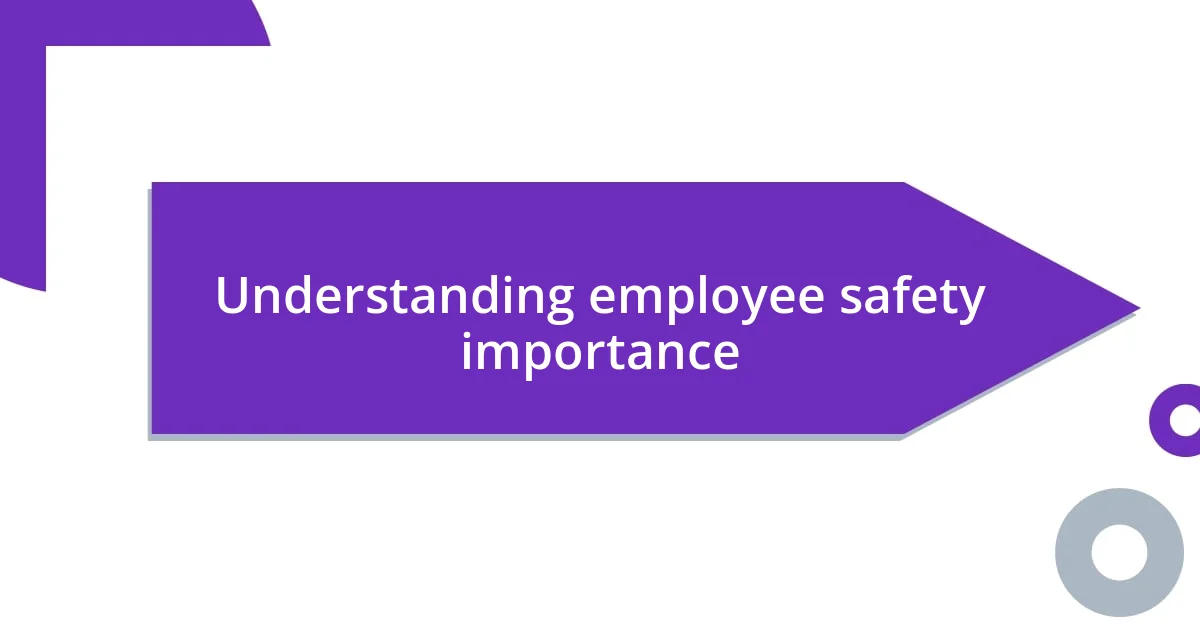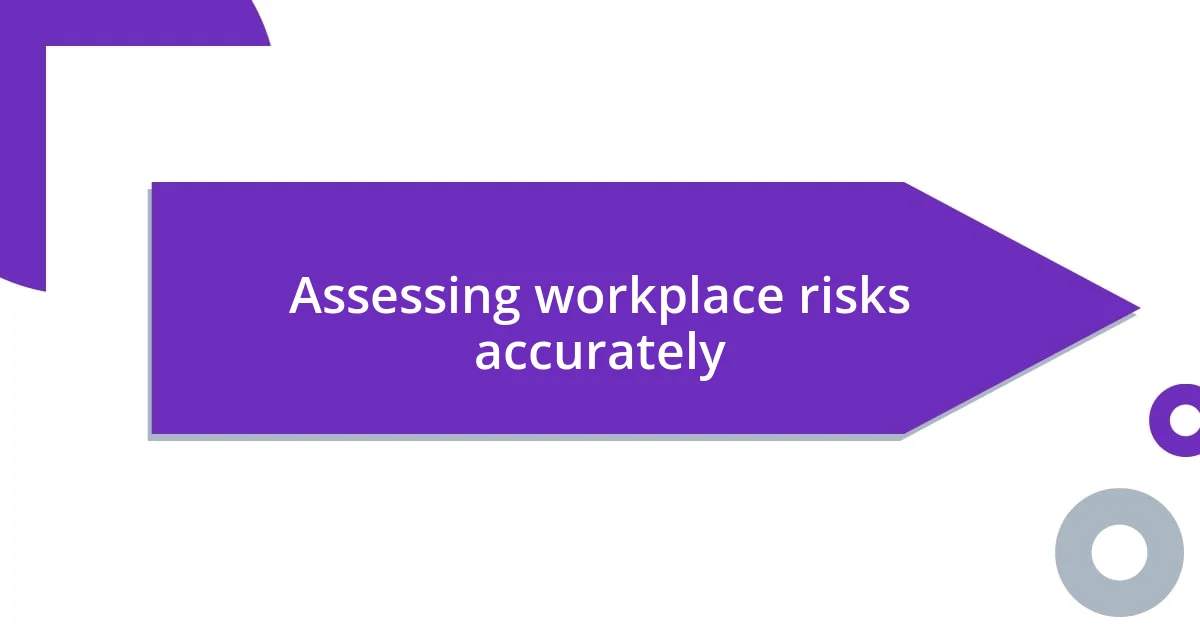Key takeaways:
- Employee safety significantly impacts morale, productivity, loyalty, and overall company culture, making it a strategic advantage.
- Engaging employees in safety assessments and feedback processes fosters a sense of ownership and accountability, enhancing workplace safety.
- Consistent leadership involvement and communication, along with recognizing safety achievements, are crucial for creating a safety-first culture.

Understanding employee safety importance
Employee safety isn’t just a checkbox on a compliance list; it’s a fundamental aspect of a thriving workplace. I remember my first job in a warehouse where safety gear felt like a nuisance. At the time, I didn’t fully grasp its importance until a colleague had a small accident that could have been avoided. That incident opened my eyes to the reality that ensuring a safe environment is vital for both morale and productivity.
When I think about employee safety, I often reflect on the emotional toll accidents can take on a team. Imagine showing up every day, knowing that the environment is risky—it’s enough to create an undercurrent of anxiety. Conversely, when employees feel safe, they are more engaged, focused, and willing to contribute. Isn’t it powerful to think about how safety can directly impact employee satisfaction and overall company culture?
Have you ever considered how investing in employee safety can translate into financial benefits for a company? A workplace free from accidents reduces costs related to compensation, liability, and operational downtime. From my experience, organizations that prioritize safety see lower turnover rates and higher employee loyalty. It’s more than just a legal obligation; it’s a strategic advantage that pays off in numerous ways.

Assessing workplace risks accurately
Assessing workplace risks accurately requires a thorough understanding of both the environment and the tasks at hand. I’ve found that conducting detailed inspections regularly is crucial. During one of our routine checks at a construction site, we discovered several loose cables that could have posed serious hazards. This proactive approach not only prevented potential accidents but also empowered the team to feel safer and more valued.
One effective method I’ve used is engaging employees in the risk assessment process. I once organized a brainstorming session where team members shared their concerns and suggestions. Their insights shed light on risks I hadn’t even considered. This collaboration not only improved safety measures but also fostered a sense of ownership among the staff, making them feel more invested in their own safety.
Creating a culture of safety involves consistently evaluating and adjusting our strategies. I believe it’s not enough just to check boxes. I often reflect on our safety drills, where we simulate emergencies that highlight vulnerabilities we might overlook on regular days. This ongoing commitment to risk assessment allows us to adapt and ensure the safety protocols remain effective and relevant.
| Method | Benefit |
|---|---|
| Regular Inspections | Proactively identifies hazards |
| Employee Engagement | Encourages ownership of safety |
| Ongoing Training | Enhances preparedness for emergencies |

Implementing proactive safety measures
Implementing proactive safety measures requires a commitment to mindfulness and anticipation of potential hazards. I recall a time when we introduced a safety suggestion box, allowing employees to anonymously contribute ideas for improvement. The excitement that built around this initiative was palpable; employees felt validated and empowered. It truly illustrated how a small change can foster a culture where safety is everyone’s responsibility.
To take proactive measures effectively, organizations should embrace a mix of the following strategies:
- Regular Training Sessions: This keeps safety practices at the forefront of employees’ minds.
- Safety Champions: Designating individuals who are responsible for advocating safety encourages accountability.
- Visual Reminders: Placing signs and alerts in high-risk areas serves as constant reminders of safety protocols.
- Feedback Loops: Creating channels for regular feedback ensures that employees can voice concerns or suggestions continuously.
- Incentive Programs: Rewarding teams for achieving safety milestones can motivate everyone to stay engaged in these efforts.
Every time I reflect on these measures, I’m reminded of how simple adjustments can significantly enhance workplace safety, both physically and emotionally. When employees see that their safety is prioritized, it nurtures a deeper connection to their work and colleagues.

Providing comprehensive safety training
Providing comprehensive safety training is one of the most essential aspects of prioritizing employee safety. I remember the first time I stood in front of a group, delivering safety training to new hires. There was a palpable tension in the room as I began discussing emergency procedures. But by the end, I could see their relief and curiosity grow. It’s fascinating how a well-structured training session can transform apprehension into confidence, putting employees in control of their safety.
In my experience, hands-on training is far more effective than just lectures. During one training session, we set up a mock emergency scenario that allowed employees to practice their responses. The laughter and teamwork that emerged as they navigated the drills were contagious. The camaraderie developed in those moments not only made the training enjoyable but reinforced the idea that safety is a shared responsibility. Isn’t it amazing how learning can spark genuine connections among team members?
Moreover, I believe that ongoing training is vital. After initial training, I provide refresher courses and update sessions that help keep safety protocols fresh in everyone’s minds. I still recall one of our refresher courses when an employee brought up a challenging situation they faced on-site. They shared how they had applied our training in real life, turning that moment into a learning opportunity for everyone. It was a powerful reminder that training goes beyond just knowledge; it’s about building a resilient workforce that feels empowered to speak up and take action.

Encouraging employee safety feedback
Creating an environment where employees feel comfortable sharing their safety feedback is crucial for fostering a culture of safety. I’ve always found that when team members know their voices matter, their willingness to speak up grows tremendously. I remember a moment when an employee shared a concern about a slippery floor; that feedback led us to implement anti-slip mats, preventing potential accidents. Isn’t it remarkable how a single voice can lead to impactful change?
To truly encourage feedback, it’s essential to show appreciation for input. I once organized a monthly meeting where we recognized employees who contributed safety suggestions, big or small. The shift in attitude was evident—more employees wanted to participate, as they saw their contributions valued. It made me realize that inspiration often springs from recognition. Have you ever thought about how empowering it is to feel like you’re part of the solution?
Establishing clear channels for feedback is another important component. One of my favorite methods has been using digital platforms where employees can submit concerns anonymously. Not only does this protect their identity, but it also fosters a candid dialogue about safety. I recall a time when our digital suggestion box revealed several insights on equipment usage that we had overlooked. It was a wake-up call, reminding me that safety isn’t just a top-down initiative; it thrives on collaboration and open-mindedness.

Regularly reviewing safety protocols
Regularly reviewing safety protocols is an essential step in maintaining a safe workplace. I still remember the first time we sat down as a team to go over our safety procedures; it felt a bit mundane at first. But as we dissected each protocol, I realized how easy it is to overlook outdated practices. Isn’t it fascinating how a simple review can breathe new life into safety measures, ensuring they are relevant to our current environment?
During our last safety protocol review, one of our supervisors raised a valid point about the increasing use of technology in our operations. As we discussed, we discovered that some protocols didn’t reflect the challenges posed by new equipment. This moment really struck me—how often do we consider the dynamic nature of our work? By continuously assessing and updating our protocols, we not only mitigate risks but also demonstrate our commitment to employee safety.
I find it helpful to involve employees in these reviews. In one instance, a team member suggested adding a new protocol for operating a recently acquired machine. Their insight was based on firsthand experience, which made it incredibly valuable. It filled me with pride knowing that our collective safety efforts had sparked such proactive thinking. Have you ever thought about how powerful it is when each employee takes part in shaping their own workplace safety? Engaging everyone reflects a culture of accountability and vigilance, ensuring safety is always at the forefront of our minds.

Creating a safety-first culture
Creating a safety-first culture starts with visible leadership commitment. I recall a time when we held a safety-awareness week, where I actively participated in training sessions alongside my team. Seeing me engaged sent a powerful message that safety wasn’t just a policy; it was a priority for every single one of us. Have you ever noticed how leadership involvement can genuinely motivate teams to embrace safety?
Another key element is consistent communication about safety practices. I once initiated weekly safety huddles, where we discussed real-time safety issues and shared stories from the week. It always amazed me how these conversations sparked a newfound awareness and camaraderie among team members. Isn’t it interesting how talking openly about our experiences can deepen our collective commitment to safety?
Finally, recognizing and celebrating safety achievements cannot be overlooked. I remember the day we celebrated a full year without workplace injuries—it was a milestone worth honoring. I was genuinely touched to hear how proud my colleagues felt as they shared their stories of vigilance. Don’t you think that celebrating success not only reinforces positive behavior but also inspires others to remain vigilant?














